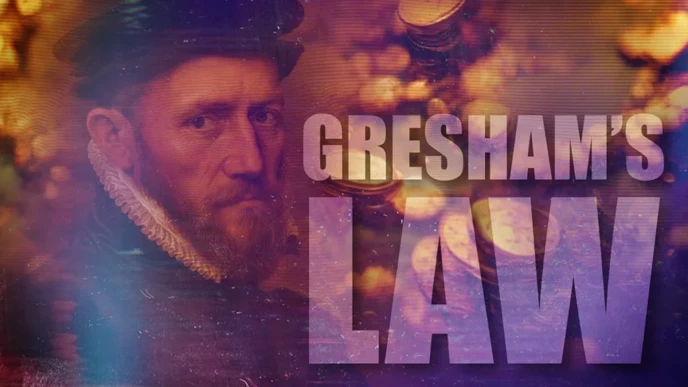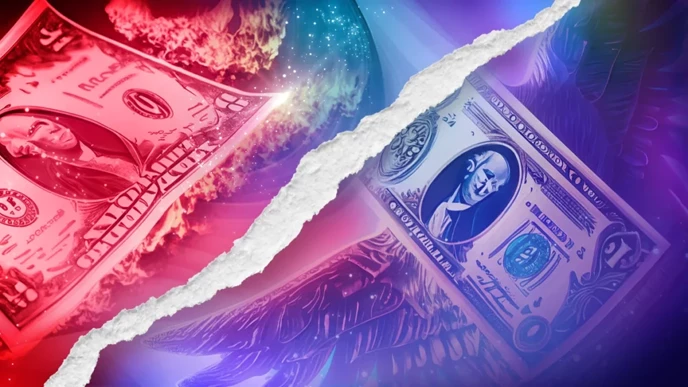Gresham's Law: Bad Money Drives Out Good Money

What is Gresham’s Law?
Gresham’s Law states that “bad money drives out good.” It is a monetary principle illuminated in economics by British financier Sir Thomas Gresham (the idea was formed centuries earlier.) This law is primarily applied to the currency markets, and was initially crafted with minted coins and precious metals in mind. The fact that Gresham’s name is still remembered today shows how much influence he has had on the financial world.
When Gresham was alive in the 1850s, a coin’s value was determined by whether it was silver or gold. However, since the use of silver and gold as currency has gone the way of the dinosaur, the law has been updated to reflect the value of modern-day global currencies, including cash and digital money, aka Bitcoin.
As an example of Gresham’s Law, let’s say there are two forms of commodity money in circulation, each of which comprises a similar face value. However, the intrinsic value of each currency is different. The currency deemed more valuable will dwindle from circulation, getting pushed out by the lesser valued currency, which by way of Gresham’s Law, becomes the preferred method for payment transactions.
There’s seemingly no real difference between these two currencies. After all, merchants will accept either one; they share similar liquidity and can be used interchangeably. However, what sets them apart is less apparent to the natural eye.
In addition to being used as a medium of exchange, currencies have other use cases, such as foreign exchange, as a commodity, or as a store of value (think Bitcoin). Bad money drives out good money because people hoard or export more valuable money with the belief that it will rise further in value (think gold), while bad money will do just fine at the till.
Good Money vs. Bad Money

When you think about good money vs. bad money, it’s clear that Gresham’s Law can still be applied today even though the currency has evolved. It becomes evident that bad money is currency whose intrinsic value is either equal to or less than its face value, whereas good money is currency whose intrinsic value exceeds its face value.
Consumers are okay with using bad money as a medium of exchange because they are not expecting its value to rise and therefore are not interested in storing it. As a result, bad money becomes the dominant currency in circulation because the paper it’s printed on is not worth much. On the other hand, good money is either undervalued or is more stable and better at storing its value than other currencies.
Gresham’s Law is made possible thanks to the legal tender laws of the land that ensure merchants cannot block bad money at the point of sale simply because it is less valuable. This is as long as an economy’s laws require that currency units be deemed transferable at the same face value.
The bridge between currency and gold, silver, and other precious metals has widened with the advent of paper notes and digital currencies like Bitcoin. The debasement of the metal currencies has fueled a wave of inflation in the lion’s share of global economies and, in the worst of situations, has resulted in hyperinflation, such as in Argentina, where the peso is worth next to nothing and Bitcoin has risen in popularity.
Why is Gresham’s Law Important?
Gresham’s law is important because we are still discussing it today, even all these centuries later.
It is a phenomenon that evolves as money changes in form and value in the economy.
Gresham’s Law and Bitcoin
Bitcoin has two primary use cases — a store of value and a censorship resistant medium of exchange.
But, since it has low throughput, and most people do not need censorship resistance, it is hardly used as a medium of exchange.
Rather , for the most part, people save their BTC as a store of value with the expectation that it will increase in value over the long term.
This is why Bitcoin has earned the nickname “digital gold,” as it competes with the precious metal in this way. It also explains why people are reluctant to spend their BTC — because they firmly believe it is “good money” and is better served sitting in cold storage somewhere.
They are considering the network effect as it relates to adoption, which, in turn, has the potential to fuel a strengthening BTC price. Ironically, they also expect Bitcoin’s role as a medium of exchange to increase alongside adoption, which should be bullish for the Bitcoin price.
You may wonder if Bitcoin is considered good or bad as it relates to Gresham’s Law.
To conclude, we will explore the following concepts:
- Spending BTC as a medium of exchange vs. saving BTC as a store of value
- Spending fiat money vs. saving it
- The costs of saving bad money
As of Q1 2021, before the crypto winter of 2022, Bitcoin’s historical CAGR (compound annual growth rate) surpassed 200%, incentivizing market participants to hoard their coins. In the U.S., even Uncle Sam characterizes Bitcoin as property in terms of tax treatment, treating each transaction involving the flagship crypto as a taxable event. Therefore, it’s understandable that people would prefer to save vs. spend their Bitcoin.
However, as Bitcoin as a payment method becomes more integrated into society, its role as a medium of exchange could also increase. This trend is beginning to take hold in Central America, where El Salvador has already elevated Bitcoin to legal tender in the economy.
As for fiat money and spending vs. saving it, consider the U.S. dollar.
The U.S. economy is among the many economies of the world currently suffering from sky-high inflation – when fiat money loses purchasing power and value. The ability of the central bank to turn the money printer on has inflated the supply and diminished the value of fiat money.
In fact, over the past century, the value of the U.S. dollar has depreciated by more than 90%. Therefore, people have no problem using their dollars as a medium of exchange, considering its value is only going in one direction — lower.
As for saving fiat money, the writing appears to be on the wall. Placing fiat money in savings would be a misnomer, considering it historically falls in value, and therefore they would only be saving peanuts. Choosing to save in bad money or fiat, such as the USD, could wreak havoc on a person’s net worth over time, based on historical dynamics surrounding the currency. Aggressive money printing and rising inflation in the U.S. dollar would have more than halved a person’s purchasing power in that same period, while most of their wealth would have been in danger of disappearing.
No wonder bad money is driving out good money.
Join The Leading Crypto Channel
JOINDisclaimer:Please note that nothing on this website constitutes financial advice. Whilst every effort has been made to ensure that the information provided on this website is accurate, individuals must not rely on this information to make a financial or investment decision. Before making any decision, we strongly recommend you consult a qualified professional who should take into account your specific investment objectives, financial situation and individual needs.

Gerelyn
Gerelyn is a financial journalist who has been covering Wall Street for more than 20 years. After reporting for some of the top trade publications on investment banking, infrastructure and retirement, she was drawn to decentralization and shifted her coverage to the blockchain and cryptocurrency space in mid-2017. Since then, she has contributed to several major Bitcoin, Blockchain, and DeFi news sites, and has also written a children’s book.

Development
Knowledge
Subscribe To Newsletter
Stay up-to-date with all the latest news about
Liquid Loans, Fetch Oracle and more.
Copyright © 2024 Crave Management.
All Rights Reserved.

The LL Librarian
Your Genius Liquid Loans Knowledge Assistant




